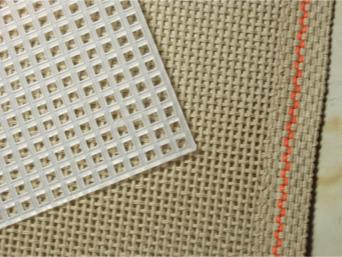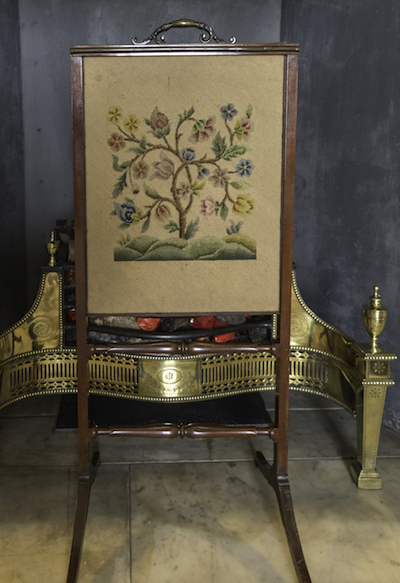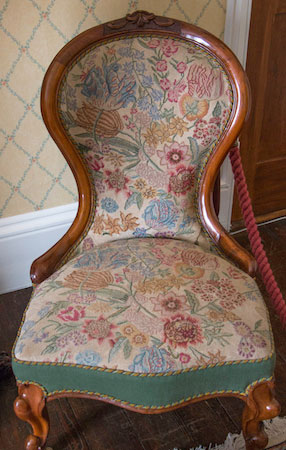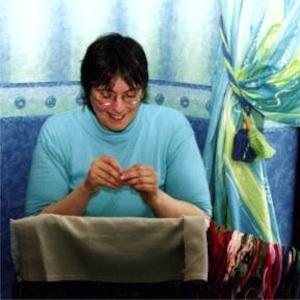- Home
- Needlepoint
Needlepoint: An Introduction to the Craft
What is needlepoint? (And is This Page for You?)
Needlepoint is a relaxing, tactile craft where you stitch coloured threads onto a sturdy canvas to create a decorative, durable surface.
It’s simple to begin, easy to pause and pick up again, and endlessly adaptable once you know the basics.
This guide walks you through what needlepoint is, what you need to get started, how to work your first small piece, and where it fits into a long stitching tradition.
Learn the different options and when you would use them Choose a Needlepoint Stitch
Pick the best one for the area you want to work Try a free downloadable pattern
Stitch a simple poppy on plastic canvas The Textures to Dye For series
Patterns to try out your new needlepoint skills
Needlepoint, canvaswork… or “tapestry”?
You’ll often see needlepoint described as canvaswork, because all the stitching is worked on a mesh canvas base.
It’s also frequently (but incorrectly) called tapestry – true tapestry is a woven technique made on a loom, not stitched with a needle.
Don’t worry if the terms get mixed up in kits and shops; the supplies and techniques you’re using here all fall under the needlepoint / canvaswork family.
Needlepoint vs Cross-Stitch
If you’ve seen cross-stitch before, think of needlepoint is its sturdier cousin. Both are counted-thread techniques, but they differ in fabric, stitches and how the finished pieces are used.
- Needlepoint is worked on a firm, open-weave canvas using straight or diagonal stitches such as tent stitch and its many variations.
- Cross-stitch is worked on softer, even-weave fabrics like aida or linen using the familiar x-shaped stitch.
Where cross-stitch usually uses stranded embroidery floss, needlepoint is more flexible: you can stitch with thick tapestry wools, finer wools and cottons, or silks and novelty threads.
Most needlepoint designs are worked as solid coverage, with very little bare canvas showing. This creates a dense, robust surface that suits cushions, rugs, kneelers, bags and other hard-wearing items.
Cross-stitch pieces often feature motifs on an unstitched fabric background and are more commonly used for pictures, samplers and small decorative items.
If you’re wondering which is “better”, there isn’t a winner. They’re simply different techniques that appeal to different stitchers – and many people enjoy both.
The Essentials: What You Need to Start
Before you take your first stitch, it helps to gather a few core supplies. These will keep your canvas stable, your stitches neat, and your threads easy to manage.
Canvas

Your main foundation is the canvas itself.
Needlepoint canvas is a stiff, open-weave mesh with clearly defined holes. Choose a piece that suits the scale of your design.
Coarser canvas with bigger holes is perfect for rugs, sturdy cushions and bold graphics. We're talking 3 - 7 holes per inch here.
Medium canvas suits a wide variety of projects and is a good place for beginners to start. I put 10 - 12 holes per inch options in this section.
Finer meshes are reserved for more intricate pictorial work where you want subtle shading and detail. This can include anything from 14 - 22 holes per inch, or even silk mesh that goes as fine as 40 holes per inch!!
Whatever you pick, cut it a little larger than the design area so you have space to handle and finish it.
You can work on plain canvas and follow a chart, or on a printed or hand-painted canvas where the design already appears on the mesh.
Threads
To cover the canvas, you’ll use threads or yarns.
Tapestry wool is the classic choice – thick, forgiving and designed to fill the holes and give solid coverage while being forgiving of small iregulatities in tension.
You can also use finer wools or cottons for lighter pieces, or silks and specialty fibres when you want sheen and extra texture. The key is to match the thickness of your thread to your canvas size so it fills the holes without straining them.
Want to explore further? See the dedicated guides to needlepoint canvas types & sizes and to choosing needlepoint fibres and threads.
Your tapestry needle
You’ll stitch with a tapestry needle – a blunt needle with a large eye.
The blunt tip slips between the canvas threads rather than piercing them, and the larger eye makes it easier to thread thicker yarns.
Pick a size that feels comfortable with both your canvas and your chosen threads.
Keeping your needlepoint under tension
Although you can stitch in hand, most people find their work improves when they use a frame, or stretcher bars.
Holding the canvas under gentle tension keeps stitches more even, reduces distortion (especially with diagonal stitches), and is easier on your hands. A small frame is enough for tiny projects; stretcher bars are useful for anything larger.
You might find a stand is also useful to rest the frame on and free your hands up.
Scissors
For cutting, a small sharp pair of embroidery scissors is ideal for trimming thread ends closely and cleanly.
A sturdier pair can live nearby for cutting canvas or thicker materials when you reach the finishing stage.
Other tools
A few small tools and organisers can make life easier: a needle threader, a pincushion, a simple laying tool for smoothing threads, and some way of keeping colours in order, such as bobbins, floss cards or a thread organiser.
A short ruler or gauge is handy if you want to check canvas size or stitch coverage.
If your canvas isn’t pre-printed, you’ll also need a pattern and marking tools.
Many stitchers simply follow a chart on graph paper, counting from chart to canvas. Others like to add light guidelines or mark key shapes directly on the mesh with a washable marker or specialist fabric pen.
Finally, think ahead to finishing. Wadding or padding for cushions and padded items, a backing or lining fabric, and either basic upholstery supplies or fabric glue will help you turn a flat piece of stitching into cushions, bellpulls, framed pieces and more.
How to start needlepoint in 5 easy steps
The easiest way to get started is with a pre-printed canvas where the design or pattern is already there for you. All you need to do is fill it in.
A simple stitch first stitch is is half cross stitch, a short diagonal stitch worked over a single canvas intersection. Using tapestry wool, those small diagonals build up into a solid, coloured surface.
Here’s a straightforward way to get going:
- Choose a canvas you like: Pick a printed canvas that appeals to you in both subject matter and colour so you'll enjoy spending time with it.
- Gather your basics: You'll need a suitable wool, a needle, something to hold the canvas, and a small pair of sharp scissors. Kits will often supply the wool and threads, but rarely the frame.
- Mount your canvas: Secure it in your frame so its helpf firmly and stays square. Half cross stitch can skew the canvas if you work on it loose.
- Practice your stitch: On a scrap of canvas or in an unobstrusive corner, work rows of half cross stitch, all leaning in the same direction. Focus on keeping your tension even and not pulling the canvas out of shape.
- Begin your design and tidy the back as you go: Start filling in the printed areas on your main canvas. As you stitch, tuck wool ends under existing stitches and trim the tails short so they don’t poke through to the front. A tidy back helps the piece lie flatter and feel more comfortable in use.
Try a simple starter project
Once you’ve gathered your supplies and tried a few rows of stitching, it’s helpful to tackle a small project that you can finish in a reasonable time. That way you can see how canvas and threads behave together from first stitch to final finish.
Two easy options are:
- Download My Free Printable Plastic Canvas Patterns and Get Creative – a set of small designs worked on sturdy plastic canvas. The shapes are compact, colourful and forgiving, making them ideal for practising tension, changing colours and keeping the back tidy.
- A Free Bargello Design for Christmas – a festive pattern using simple repeated stitches to create the flowing, flame-like look of Bargello. It’s a gentle introduction to working over different numbers of canvas threads and planning colour changes, with a very satisfying end result.
Each project comes with full instructions, so you can focus on building confidence rather than inventing everything from scratch.
What can you make with needlepoint
Once you know a few stitches, needlepoint slips very easily into everyday life.
The same basic canvas and threads can become practical objects, decorative accents or miniature works of art.
Designs might be pictorial – flowers, animals, landscapes – or they might be all about pattern: bold geometrics, repeating Bargello flames, or modern, semi-abstract shapes.
At one end of the scale you have tiny pincushions and scissor fobs; at the other, large wall hangings and rugs. Historic houses such as Wallington in Northumberland are full of examples of stitched furnishings used on a grand scale.
In between those extremes are all sorts of useful projects: cushions and pillows, chair seats, door stops, belts and straps, book covers, dollhouse carpets, church kneelers, firescreens, Christmas ornaments, dog collars, bags and totes.
If it can be covered in sturdy fabric, there’s a good chance someone has needlepointed it.
A brief history of needlepoint
If you’re curious about where needlepoint comes from, it has a long, practical and decorative history.
When Cushions Were King (and Benches Were Hard!)
Way back in the 16th century, life was... well, a bit splintery. Most folks were sitting on hard, unforgiving wooden benches. Ouch. This is where needlepoint swooped in to save the day (and our behinds!).
Creating cushions wasn't just practical; it was a way to bring colour and comfort into a home. Amateurs and professional stitchers alike were busy creating these pillowy masterpieces.
They also stitched huge, decorative cloths to cover simple tables and cupboards, turning everyday items into works of art. Can you just imagine the pride they felt, creating something that was both useful and beautiful? We still feel that today!
One of the popular techniques from this time was a flashy little number called flamestitch. We now know it as Bargello, where simple vertical stitches line up to create incredible geometric patterns. It’s proof that stitchers have always known how to make a statement.
From Practicality to Purely Pretty
Fast forward to the 18th century, and things started to change. With more woven fabrics available for everyday needs, stitchers had the freedom to create pieces just for the sheer joy of it.
This is when needlepoint really got to dress up and show off!
Intricate fire screens, delicate little pictures, and all sorts of ornamental treasures began to appear. The designs became more realistic and flowing, capturing the elegance of the era. It was less about necessity and all about creative expression - a feeling every modern stitcher knows and loves.
 Crewel-style firescreen worked in needlepoint tent stitch
Crewel-style firescreen worked in needlepoint tent stitchThe Victorian Version of a Kit
Then came the Victorians and their absolute obsession with a technique called Berlin wool work. Think of it as the 19th-century version of the needlepoint kits we adore today!
They used brightly coloured, printed charts that made it easy for anyone to create incredibly detailed designs.
From fuzzy dogs to lavish floral arrangements, you could stitch just about anything.
It made needlepoint more accessible than ever, bringing a whole new wave of people into the craft. (And yes, some textile experts today look back and say the stitching wasn't as finessed as earlier work, but hey - they were having fun, and that’s what matters!)
Your Chapter in the Story
Isn’t it fascinating? The popularity of needlepoint has ebbed and flowed through time, shifting from a household necessity to a refined art form to a beloved hobby.
Every time you pick up a canvas, you’re not just starting a project; you’re connecting with centuries of creators who found comfort, joy, and a sense of accomplishment in the simple act of stitching.
So, welcome to the club. We’re thrilled to have you. What story will your stitches tell?
Other pages about the history of needlework
Ready to take your first stitch?
Needlepoint doesn’t have to be complicated or intimidating.
With a piece of canvas, some suitable threads, a blunt needle and a small project to try, you have everything you need to begin. Start with a pre-printed design or one of the free small projects, practise your basic stitches, and enjoy the moment when an empty canvas gradually fills with colour and texture.
Whether you eventually make cushions, bags, rugs or tiny ornaments, you’re joining a long tradition of stitchers who’ve used needlepoint to add comfort and character to their homes – one stitch at a time.
Stay connected between projects
If you’d like occasional updates from my embroidery room, including new patterns, gentle tips, and little things I think you might enjoy, you’re warmly invited to join the Stitchin’ Times newsletter.














